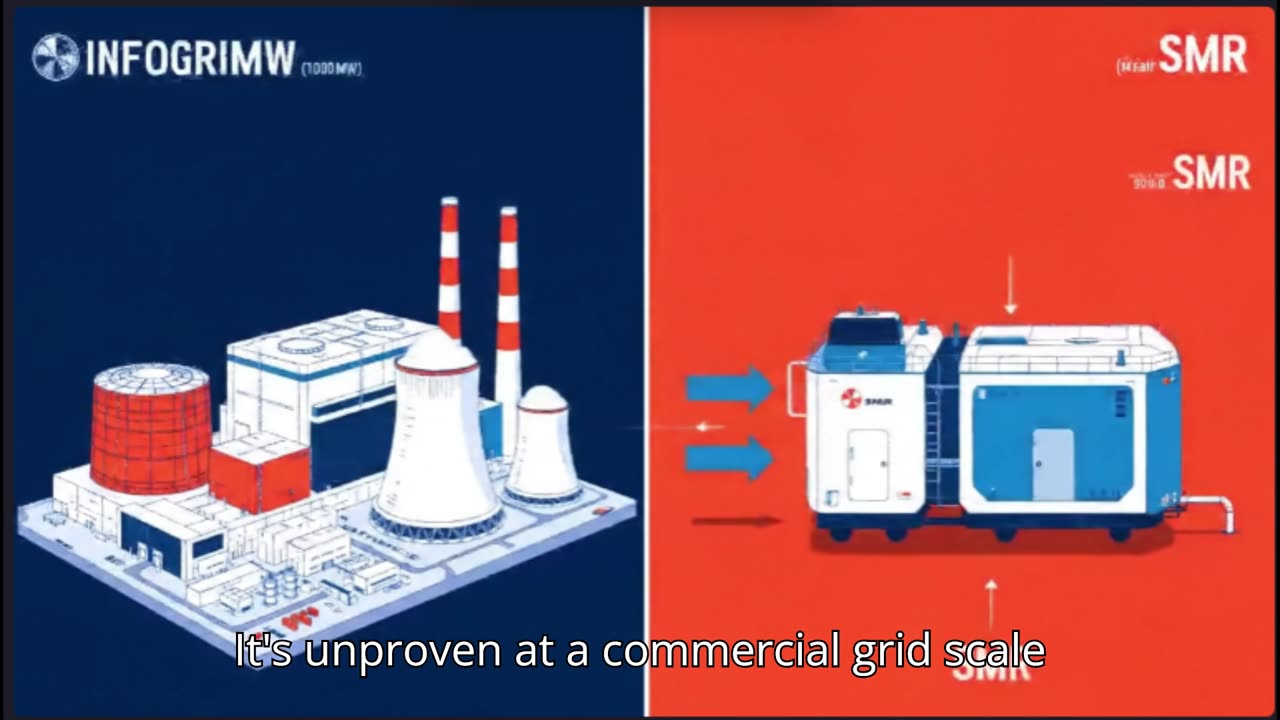Premium Only Content

The Role of Small Modular Reactors (SMRs) in Future Energy Systems
1. SMRs as a Solution for Energy Diversification and Decarbonization:
Addressing Energy Needs and Climate Goals: SMRs are increasingly viewed as a viable option to meet growing energy demands and contribute to climate goals by reducing carbon emissions. Many countries are re-evaluating their energy strategies to incorporate nuclear energy, specifically SMRs, to achieve Net-zero targets. The "decarbonization of the energy industry is one of the key pillars in the reduction of greenhouse gas emissions in the atmosphere." (Schaffrath et al., 2021, citing Vinoya et al., 2023).
Supplementing Renewable Energy: SMRs are presented as a solution for "renewable energy gaps," offering a stable and dispatchable power source that can complement intermittent renewable energy generation (Zarębski & Katarzyński, 2023). This is crucial for "enhancing grid reliability" and mitigating the impact of increasing intermittent electricity production on frequency stability (Zarębski & Katarzyński, 2023, citing Boudot et al., 2022).
Transition from Fossil Fuels: SMRs offer a pathway for countries heavily reliant on fossil fuels to transition to cleaner energy. Poland, for instance, is "actively exploring the application of nuclear power as a substitute for its present reliance on fossil fuels for the generation of heat and electricity" (Zarębski & Katarzyński, 2023, citing Chmielewska-Śmietanko et al., 2024).
2. Advantages of SMRs for Developing Economies:
Addressing Investment and Grid Challenges: For countries like Uganda, pursuing large nuclear reactors presents significant challenges due to "huge investments in construction and grid expansion required considering the small size of Uganda’s economy and grid" (Daniel & Kim, 2022). SMRs, with their smaller capacity and modular design, offer a more manageable investment and integration pathway.
Increased Safety and Flexibility: SMRs are highlighted for their "increased safety, flexibility, and…" advantages over traditional large-scale nuclear reactors (Schaffrath et al., 2021, citing Chalkiadakis et al., 2023). Their modularity also contributes to "lower capital costs for research, development, and construction" (Zarębski & Katarzyński, 2023, citing Ghimire & Waller, 2023).
Support for Rural Electrification and Distributed Generation: While not explicitly detailed in the provided excerpts, the "small footprint" of SMRs (Zarębski & Katarzyński, 2023, citing Ghimire & Waller, 2023) and their modular nature suggest potential for decentralized power generation, which could support rural electrification efforts (Daniel & Kim, 2022, citing Cartland et al., 2023).
3. Critical Considerations for SMR Integration:
Comprehensive Assessment and Planning: The integration of SMRs necessitates "a meticulous assessment of various factors, spanning renewable energy potential, legal frameworks, technical considerations, community engagement, and consumer preferences" (Zarębski & Katarzyński, 2023). This underscores the need for "comprehensive analyses before deciding to implement SMRs."
Site Selection: Geographical considerations are paramount for SMR site selection (Zarębski & Katarzyński, 2023, citing Almalki et al., 2019, and Zhang et al., 2020). This involves careful evaluation to ensure environmental suitability and safety.
Legal and Safety Frameworks: The development and deployment of SMRs require robust legal and safety frameworks. "Safety culture issues, and the need for an improved international safety regime" are critical aspects of expanding nuclear power technology to new countries (Daniel & Kim, 2022, citing Budnitz et al., 2018).
Techno-Economic Feasibility: Studies emphasize the importance of assessing the "techno-economic feasibility" of SMR systems, including their integration with other energy sources like hydrogen (Schaffrath et al., 2021, citing Chalkiadakis et al., 2023). Tools like the MESSAGE tool are used for "optimal long-term electric power strategy" (Daniel & Kim, 2022, citing Esmail & Cheong, 2021).
Automation and Intelligent Control: SMRs are "advancing towards increased degrees of automation and intelligence, with intelligent control emerging as a prominent trend in SMR development" (Zarębski & Katarzyński, 2023, citing Ren et al., 2024). This reflects a focus on optimizing their operation and safety.
4. International Development and Expertise:
Global Interest and Development: SMRs are a subject of "increasing global interest" and are considered an "interesting option for new builds in most countries worldwide which continue to use nuclear energy for commercial electricity production" (Schaffrath et al., 2021). Currently, various SMR designs are in operation, construction, or licensing stages globally.
Technical Support and Simulation: Organizations like the Gesellschaft für Anlagen- und Reaktorsicherheit (GRS) gGmbH are actively involved in "dealing with small modular reactors (SMRs) for about one decade," developing and validating methods for their simulation and safety assessment (Schaffrath et al., 2021).
Knowledge Sharing and Collaboration: The multiple citations across the sources, particularly those referencing international studies on energy systems modeling and nuclear power adoption in various countries (Saudi Arabia, Nigeria, Egypt, Indonesia, Ukraine), underscore a global effort and shared learning in this field.
In conclusion, SMRs are emerging as a compelling option for future energy systems, offering a promising pathway for sustainable development, energy security, and decarbonization, especially for economies with specific grid and investment constraints. However, their successful integration hinges on thorough planning, robust regulatory frameworks, and continued international collaboration in research and development.
Daniel, Niwagira and Juyoul Kim. “A Study on Integrating SMRs into Uganda’s Future Energy System.” Sustainability (2022): n. pag.
Schaffrath, Andreas, Andreas Wielenberg, Robert Kilger, and Armin Seubert. "SMRs—overview, international developments, safety features and the GRS simulation chain." Frontiers in Energy 15, no. 4 (2021): 793-809.
-
 30:55
30:55
TruthStream with Joe and Scott
7 days agoTruthStream in Ireland, Rebels Across the Pond, Bono discussed, with Freedom Now Acoustic from a Pub
7.2K12 -
 3:12:34
3:12:34
Badlands Media
1 day agoThe Narrative Ep. 43: Unity.
346K82 -
 2:43:11
2:43:11
TheSaltyCracker
9 hours agoWe Kill You Rally ReeEEStream 10-19-25
93.9K255 -
 7:54:17
7:54:17
Putther
15 hours ago $27.55 earned🔴LAZY SUNDAY STREAM!! (GTA + MORE)
77K12 -
 10:38
10:38
Colion Noir
8 hours agoHe Installed a Forced Reset Trigger at a Gun Range… and Got Arrested | What You Need to Know
59.8K23 -
 1:29:26
1:29:26
HELMETFIRE
8 hours ago🟢GAMING WITH FIRE EP13🟢
31.3K5 -
 50:40
50:40
Sarah Westall
10 hours agoAI, Social Media & Brain Atrophy: Destroying Human Capacity to Think w/ Rob Smith
37.1K12 -
 2:32:08
2:32:08
THOUGHTCAST With Jeff D.
7 hours ago $19.60 earnedSunday Night FORTNITE with THOUGHTCAST Jeff D & crew.
39.5K7 -
 55:10
55:10
The Mel K Show
15 hours agoMel K & Mike L | The Tylenol Piece: It's a Marathon, Not a Sprint | 10-19-25
100K14 -
 3:17:37
3:17:37
MrMoBetta13
8 hours ago $8.44 earnedCFB26 CUT Ranked + NEW NIGHTMARE CARDS and talking college football!!
30.1K8